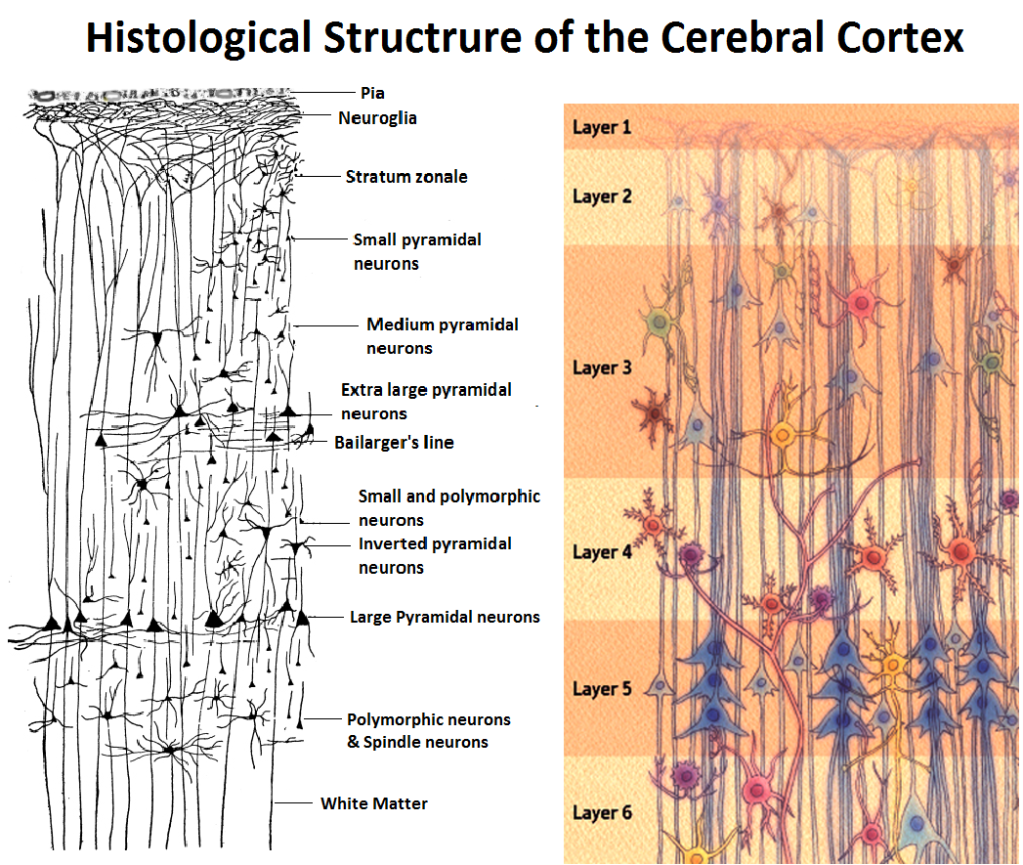more fully: cerebral cortex
The outter layer of the Cerebrum, which contains most of the cell bodies (soma) of the Neurons in it.
It is where most Neural circuits associated with higher order cognitive reside. See Neuroscience.
Types of cortex
The cortex can be divided into:
- The isocortex, or neocortex, the newer evolutionarily. The white matter is inside, and the gray matter outside. It is traditionally divided into six layers. When we say cortex, we will refer to this, in general.
- The allocortex. White matter is outside; Gray matter is inside. Three layers. Older evolutionarily. Contains paleocortex, hippothalamus, and the periachicortex (see here).

Cortical anatomy
see here
 another image
– another image
another image
– another image
Cortical function (information processing)
Each cortical region applies operations to different types of data and produces different types of results according to the afferent and efferent connections of the region [Braitenberg, 1977].
The study of the foundamtental computations that are applied through out the cortex is known as Corticonics.
Connections with other brain regions (Connectomics)
The physiological evidence that properties of neurons tend to be organized in radial columns also contributed to the concept that the intracortical mesh of axonal and dendritic branches is used only for local processing of information, not for transmission across the cortex. Therefore information is mostly transmitted, over long distances, through White matter.
There are many statistical properties regarding where the afferents (carrying towards) and efferent (receiving from) nerve endings in the cortex lie, depending on the type of White matter connection. Also different cortical regions map are connected to different zones.
Probability of synaptic contatct between neurons in the cortex
One of the principal reasons to evaluate the probability of such contact is to compare the evaluated (theoretical) probability and the experimental find-ings. Such comparisons can reveal the existence of rules that govern the connectivity between neurons.
probability of contact between two neurons can be assessed when measurements of the extent of axonal branching for the presynaptic cell and dendritic branching for the postsynaptic cells are available.
Uniform distribution
The basic equation for calculating the probability of contact is obtained by assuming that the presynaptic cell distributes its synapses uniformly within a given volume and by assuming that all the neurons within that volume have the same likelihood of receiving those synapses.
, where is the number of neurons it makes contact with within the synaptic range, and is the total number of neurons within that range.
The equations derived thus far present a rather poor approximation of the real situation in the cortex, because they ignore two important fac- tors: The synapses generated by an axon usually are not limited to neurons whose cell bodies are within the axonal range, because neurons located at the fringe of the axonal range usually have dendrites that extend into the axonal range and may also receive synapses. Further- more, the density of the synapses within the axonal range need not be uniform.
Corrections due to extent of dentritic tree
Non-uniform distribution
Neuroanatomy of the cortex
Neuronal staining methods are traditinally used to study the microanatomy of neurons.
Embryogenesis of the cortex
Embryogenesis of the central nervous system: neural plate-> neural tube. First, the lateral ventricles precursors, whose walls expand into the white matter and cortex. Simultaneously the thalamus mattures. Then neuroblasts migrate to cortex and specialize. First pyramidal neurons, then stellar neurons. As they arrive these grow their axons and dendrites.
"This chapter has shown that many features of the cortex are results of the processes that lead to its formation. Yet it is impossible to discern which features are merely by-products of these rules, and for which features nature "went out of its way" to assure their generation. Is the radial arrangement of neurons in the mature cortex merely a by-product of their guidance into the cortical plate by the radial glial fibers? There are no clear answers in these matters, but we should remain open to all the possibilities. " ~ Corticonics, Abel, 1994.
Quantitiative data
- Density of neurons in cortex: about 40000/mm3. About 2mm thickness.
- Most are pyramidal. 85% are excitatory (pyramidal or spiny stellar), 15% inhibitory (smooth stellar).
- There is considerable variation within cortical regions, and species.
- About synapses/mm3. About half of the synapses from local cortical neurons, and the other half from farther away cortical neurons through white matter.